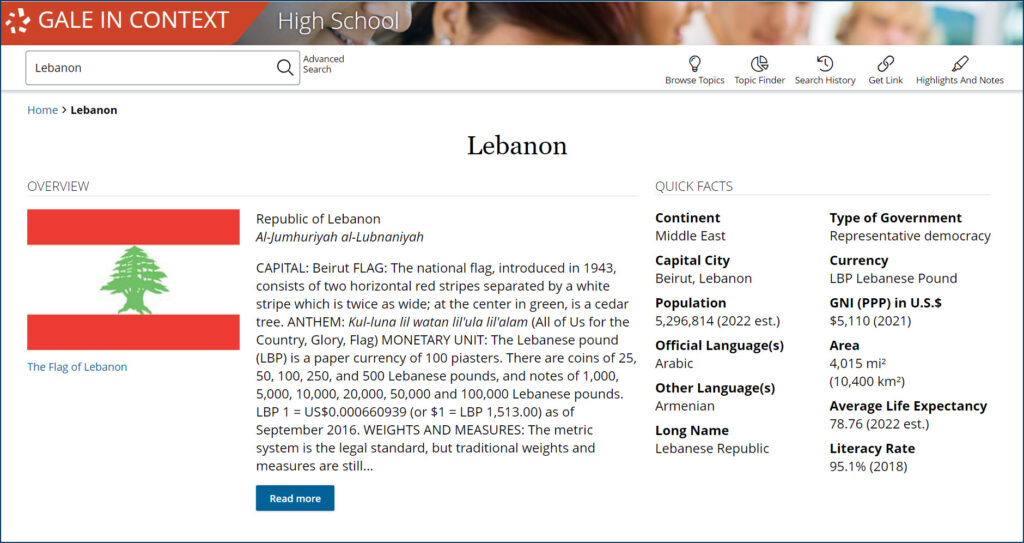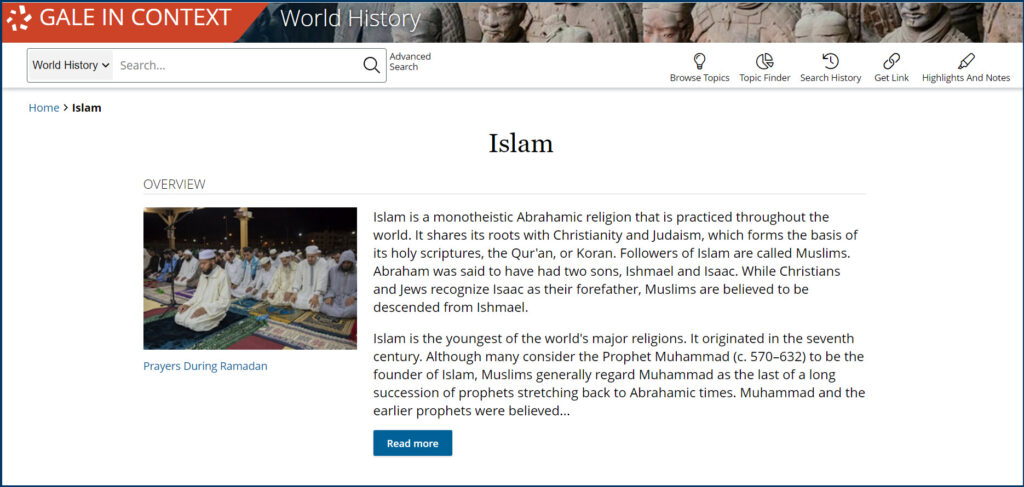| By Gale Staff |
After the collapse of the Ottoman Empire, France occupied Lebanon for several decades. Only after mounting international pressure on the French during World War II did Lebanese independence finally become a reality on November 22, 1943. With unrest dominating the headlines today, this is an important opportunity to highlight the region’s cultural diversity and extensive history, adding a valuable dimension to an area often misunderstood by Americans.
Lebanon is a small, densely populated Middle Eastern country situated between Syria and Israel. At just 4,000 square miles, it is smaller than the state of Connecticut—yet its population exceeds that of the US state by nearly 2 million people.


With over 150 miles of coastline along the Mediterranean Sea, the country enjoys an incredibly fertile environment rich in biodiversity. Plant life of all kinds thrives in Lebanon: olives, figs, valuable hardwoods, apples, and bananas. Most Lebanese people are bilingual (Arabic and French), and their staple dishes combine numerous culinary influences.
Lebanon is a parliamentary democracy. According to their constitution, the Lebanese people elect deputies for 128 parliamentary seats, equally divided between Christians and Muslims. About two-thirds of the Lebanese people are Muslim, while the remaining third are predominantly Christian. However, the religious landscape is far more diverse; in total, Lebanon officially recognizes 18 religious groups.
As a class, take advantage of Lebanon’s Independence Day on November 22 to learn more about this country’s determined quest for sovereignty despite the area’s tumultuous history, which has seen the rise and fall of empires and changing governance. Using Gale In Context: World History and Gale In Context: High School, create a timeline that outlines Lebanon’s journey to independence and provides vital context to the region’s deeply complex issues.
Explore Lebanon’s Ancient Roots
For centuries, the Phoenicians ruled the Levant—the eastern Mediterranean region encompassing Lebanon and neighboring countries like Palestine and Israel. Successful explorers, academics, and traders, the Phoenicians established several significant economic and cultural centers, including Berytus—now Lebanon’s capital city, Beirut. The Phoenicians’ expansive trade routes made them wealthy and helped spread knowledge throughout the ancient world.
539 BCE: The Persian Empire (now Iran), led by Cyrus the Great, conquers the Phoenicians. Despite besting the Levant’s people, Cyrus the Great instills a policy of tolerance for the local customs and religions.
332 BCE: Alexander the Great defeats the Persians in his mission to create the Macedonian Empire, which stretches from Greece to India and includes modern-day Lebanon.
323 BCE: Alexander the Great dies, and his empire splits apart. The former Levant region falls under Roman rule (64 BCE) and then the Byzantines (390 CE). During this transitional period, Christianity flourishes in Lebanon and continues to dominate the region throughout the Byzantine period.
636 CE: While its roots extend far earlier, most scholars date Islam’s formal creation around the early seventh century in modern-day Saudi Arabia. The religion spreads quickly throughout the Arabian Peninsula and soon threatens the established Christian civilizations around the eastern Mediterranean. Tensions spark the Battle of Yarmuk. This conflict marks a major turning point in the region and provides a foothold for the Islamic faith in Lebanon.

Throughout the Middle Ages, Islam slowly replaced Christianity as the region’s dominant religion. However, the Arab invaders did not force Islamic culture or religious conversion on the people of the Levant. Islam’s success was largely fueled by intermarriage and economic self-interest (non-Muslims had to pay higher taxes). Unsurprisingly, the mingling cultures and religious practices created new sects and unique customs.
Chart Lebanon’s Path to Independence
In the early 16th century, the Ottoman Empire invaded Lebanon. Led by Suleiman the Magnificent, the Ottomans expanded their territory throughout Asia, Africa, and Europe and ruled until the twentieth century. Despite its belief in one religious authority and reliance on political violence, the Ottoman Empire invested heavily in advancements in science and art, modernizing the region.
1860: Fighting breaks out between Christian and Muslim sects settled on Mount Lebanon, igniting a bloody civil war in the region. European diplomatic pressure helps resolve the conflict, and a semi-autonomous Christian Mutasarrifate (an administrative division of the Ottoman Empire) takes control. This transition of power lays the foundation for modern Lebanon.
1914: The Ottoman army enters World War I and sides with the Central Powers (including Germany, Austria-Hungary, and Bulgaria). The Central Powers are defeated in 1918, initiating the decline of the Ottoman Empire.
1919: A Christian delegation from Mount Lebanon attends the 1919 Paris Peace Conference, advocating for independence. However, conference leaders from the Allied nations instead split the Ottoman Empire and grant occupation rights over much of the Middle East to European interests. Lebanon falls under French authority, undermining the former’s sovereignty and leaving the region in an extended state of disorder.
1926: Under the new French mandate, modern Lebanon is formed. The new Lebanese Republic, while still under French influence, establishes its constitution. Their constitution outlines a need for equal representation of Christian and Islamic members in its governance, creating a unique governance model that embraces cultural diversity and religious plurality.
1941: In the midst of World War II, British forces invade Lebanon to protect their trade routes and prevent the German army from entering Africa. They tangle with the Vichy-led French army, and a five-week battle, known as the Syria-Lebanon Campaign, ensues. The Allies reclaim the region. Following the conflict, exiled French President Charles de Gaulle visits Lebanon, and the people once again petition for independence.
1943: Finally, in November 1943, several countries, including the United States, formally recognize Lebanese independence. However, the French continue to push back and even imprison the newly elected Lebanese president Bechara El Khoury. Despite religious differences, the Lebanese people unite, and international pressure forces the French to concede to Lebanese demands. On November 22, 1943, Lebanon becomes a sovereign nation.
From the time of the Phoenicians and Persians to the Ottomans and French in the 20th century, the Lebanese people have constantly adapted and evolved, blending new customs with the old. As students explore their history, encourage them to reflect on the country’s resilience throughout the centuries and how the people adapted to ever-changing colonization and external influence.
Despite its successful bid for independence, Lebanon’s people continue to struggle for stability and peace. The country’s history creates a complicated legacy of religious tension and harmony. Regardless, Lebanese Independence Day symbolizes its people’s perseverance as they continue to strive for a future where people of all backgrounds can thrive.
Excited to learn more? Contact your local sales representative for additional information.

